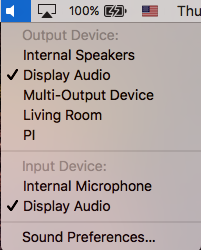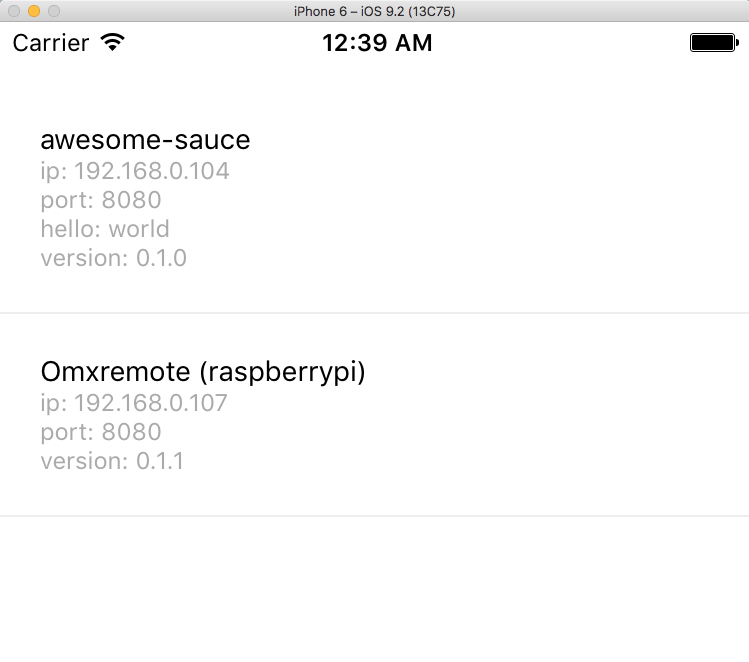How To Use Zeroconf To Register Itself
Zeroconf is a set of technologies that allow services and devices on the network to be discoverable. It'southward also known as Bonjour / Avahi / mDNS. For case, Apple uses mDNS to find any continued speakers, Apple Tv and many more than. Basically whatsoever client on the network can observe another service or device for a sure protocol and detect it's IP (4/6) address and other useful data without any demand to configure annihilation manually.
You lot can run across here some of the services discovered over the network (Living Room, PI):

Few years ago i created omxremote, a simple media thespian built for Raspberry PI and powered past omxplayer that specifically ships with PI. Omxremote provides a web ui to view files and offset playback along with an internal API that wraps calls to omxplayer. That'southward pretty much it. One problem though: my raspberry pi unit ordinarily does non have a persistent IP address (aka 192.168.0.x). So to admission the web ui i need to know the accost beforehand.

While the initial omxremote implementation worked fine for a while, i was interested to run into if i could make a react native app for my iphone. The goal was to take the app to effigy out the IP/Port of the omxremote API without any manual niggling. One time the service is discovered the app would make all the API calls just like it would with the hardcoded url.
With zeroconf each service has to register itself with the service type / name / domain. You can find more than information near bachelor types here. Omxremote is written in Become so i found a third-party library that provides Zeroconf capabilities. Essentially, when the omxremote starts we annals the service for others to notice. Lets look at the instance lawmaking:
package chief import ( "fmt" "log" "net/http" "github.com/grandcat/zeroconf" ) // Our fake service. // This could be a HTTP/TCP service or whatever you want. func startService() { http.HandleFunc("/", func(rw http.ResponseWriter, r *http.Request) { fmt.Fprintln(rw, "Hello world!") }) log.Println("starting http service...") if err := http.ListenAndServe(":8080", nil); err != nil { log.Fatal(err) } } func master() { // Start out http service go startService() // Actress information about our service meta := []string{ "version=0.1.0", "hello=earth", } service, err := zeroconf.Annals( "awesome-sauce", // service instance name "_omxremote._tcp", // service type and protocl "local.", // service domain 8080, // service port meta, // service metadata nil, // register on all network interfaces ) if err != nil { log.Fatal(err) } defer service.Shutdown() // Sleep forever select{} } Compile the lawmaking and start the service. Once its up and running it will advertise itself as _omxremote._tcp over the network. You can apply dns-sd tool that ships with OSX to discover our service:
$ dns-sd -B _omxremote._tcp Browsing for _omxremote._tcp DATE: ---Thu 07 Sep 2017--- twenty:27:26.470 ...STARTING... Timestamp A/R Flags if Domain Service Blazon Instance Name 20:27:26.471 Add together 2 4 local. _omxremote._tcp. awesome-sauce Once discovered we want to know which IP/PORT the service is listening on. Let audit:
$dns-sd -L awesome-sauce _omxremote._tcp Lookup awesome-sauce._omxremote._tcp.local DATE: ---Thu 07 Sep 2017--- 20:29:01.440 ...STARTING... 20:29:01.441 awesome-sauce._omxremote._tcp.local. can be reached at Dan-Due south-Macbook.local.local.:8080 (interface four) version=0.1.0 howdy=earth We can likewise utilise avahi-browse on linux to observe and resolve the services:
$ avahi-browse -a -r + wlan0 IPv4 awesome-sauce _omxremote._tcp local = wlan0 IPv4 awesome-sauce _omxremote._tcp local hostname = [Dan-S-Macbook.local.local] address = [192.168.0.104] port = [8080] txt = ["hello=earth" "version=0.i.0"] Then all that info we used to annals the service is available. To make this tutorial complete, lets write another Become program that will observe and talk to the service we created earlier.
parcel main import ( "context" "fmt" "io/ioutil" "log" "net/http" "github.com/grandcat/zeroconf" ) func serviceCall(ip string, port int) { url := fmt.Sprintf("http://%v:%v", ip, port) log.Println("Making telephone call to", url) resp, err := http.Go(url) if err != nothing { log.Fatal(err) } defer resp.Body.Close() data, _ := ioutil.ReadAll(resp.Body) log.Printf("Got response: %due south\n", data) } func chief() { resolver, err := zeroconf.NewResolver(nil) if err != zilch { log.Fatal(err) } // Channel to receive discovered service entries entries := make(chan *zeroconf.ServiceEntry) get func(results <-chan *zeroconf.ServiceEntry) { for entry := range results { log.Println("Plant service:", entry.ServiceInstanceName(), entry.Text) serviceCall(entry.AddrIPv4[0].String(), entry.Port) } }(entries) ctx := context.Background() err = resolver.Browse(ctx, "_omxremote._tcp", "local.", entries) if err != zippo { log.Fatalln("Failed to browse:", err.Error()) } <-ctx.Washed() } Once nosotros start the program it volition try to find all bachelor _omxremote._tcp services and try to brand a unproblematic HTTP call:
$ go run zeroconf_discover.go 2017/09/07 20:46:07 Found service: crawly-sauce._omxremote._tcp.local. [version=0.one.0 hi=world] 2017/09/07 20:46:07 Making phone call to http://192.168.0.104:8080 2017/09/07 20:46:07 Got response: Hello earth! It worked! That's absurd, and so we cat start building self-discoverable stuff. Zeroconf could useful for IOT devices as long every bit they support mDNS protocol. Based on the examples above i added zeroconf support to omxremote.
Every bit i've mentioned before i was working on the react native app to go the omxremote service discovered, i found react-native-zeroconf packet that only does that. Heads up: if you lot're using Expo it volition not work due to it's lack of support for the native packages. You'll take to gyre with blank react native app instead.
Added a basic view to discover all omxremote services:

On the screenshot above i really have two services running, ane on my local machine and some other one on the raspberry pi. We also get to see service metadata. This metadata could be used for any configuration / setup steps that your service or client might require.
That'due south it! Hope you enjoyed the overview.
How To Use Zeroconf To Register Itself,
Source: https://sosedoff.com/2017/09/07/zeroconf.html
Posted by: millerthspolies.blogspot.com


0 Response to "How To Use Zeroconf To Register Itself"
Post a Comment